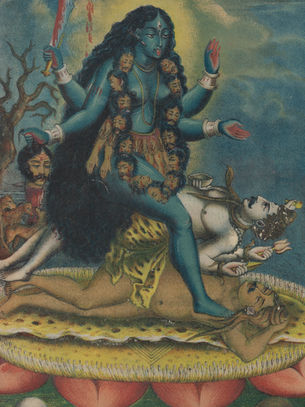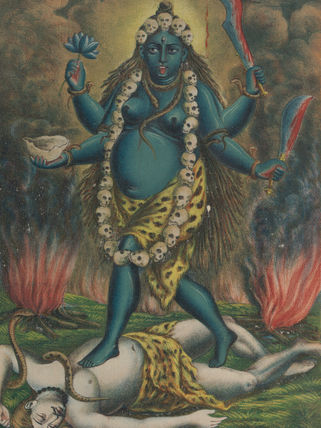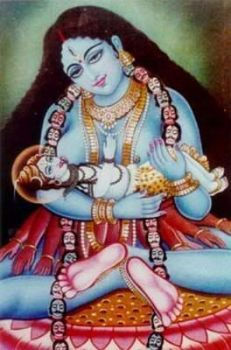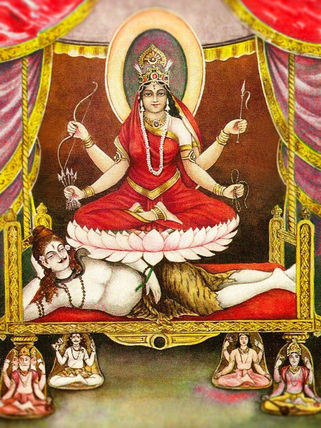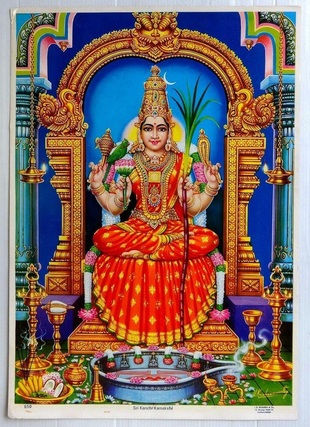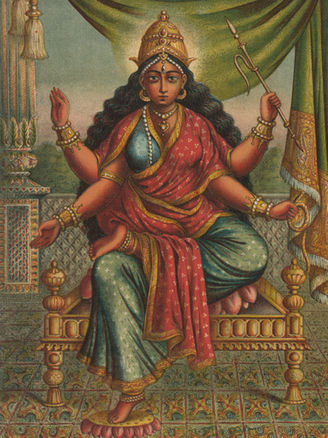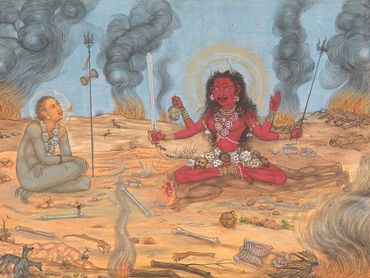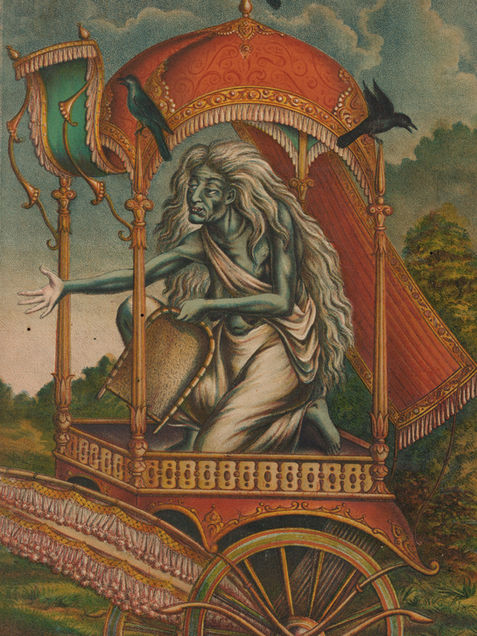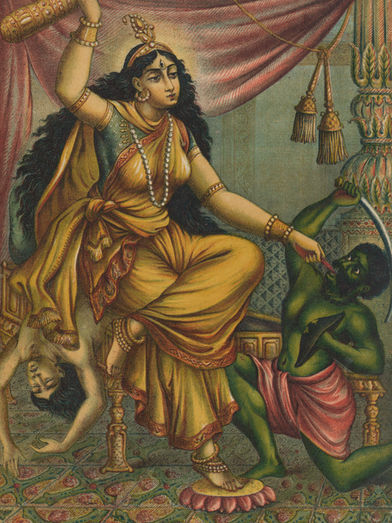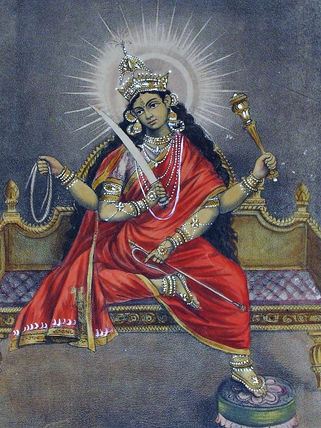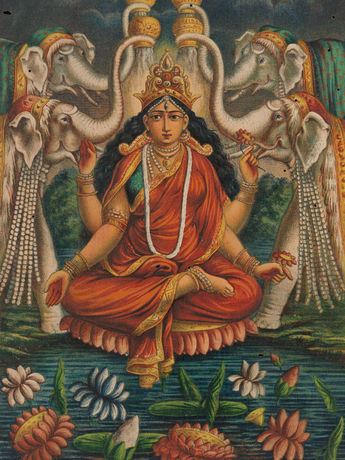
Mahavidya
Mahavidya is a group of Tantric goddesses, often considered the manifestations of Kali. Each of them represents a distinct principle of existence and a path of self-realization. Although Mahavidya is listed in a group of ten, any goddess who offers vidya (correct knowledge), siddhi (attainment), and moksha (liberation) is called Mahavidya. The primary ten goddesses in this group are Kali, Tara, Tripura Sundari, Bhuvaneshvari, Bhairavi, Chhinnamasta, Dhumavati, Bagalamukhi, Matangi, and Kamala, led by goddess Kali herself. The Guhyati Guyha-tantra connects the ten goddesses with the ten incarnations of Vishnu, where the incarnations of Vishnu arose from the Mahavidyas. Various Dhyana Mantras or respective traditions around each Mahavidya goddess cite various other forms of the ten goddesses which represent further characteristics or wisdom retained by them.
Kali
The first of the ten Mahavidyas is Goddess Kali. She embodies Shakti in her most powerful form, which causes both creation and destruction. She challenges her followers to overcome their fears and ignorance while imparting a profound understanding of life. Kali is usually shown standing or dancing on Shiva’s laying beneath her. She is always depicted in a black or dark blue complexion with long unkempt hair, ornamented with severed arms on her waist and a garland of severed human heads or skulls, called mundamala. The Guhyati Guyha-tantra associates Kali with Krishna, the eighth avatar of Vishnu. (Read: Kali)
Tara
She is the goddess associated with “sound”. She is who guides, protects, and provides knowledge that gives salvation. Her iconography is very similar to Kali's. She has a blue complexion, unkempt hair, adorned with a crescent moon on her head and a garland of skulls, and wearing a cloth of tigers skin. She is depicted with three eyes, and four arms carrying a blue lotus, scimitar or sacrificial sword, skull cup, and scissors. Her left foot is shown on the chest of Shiva. The Guhyati Guyha-tantra associates Tara with Rama, the seventh avatar of Vishnu.
Tara is also linked with Neel Saraswati (Read: Saraswati) and the Buddhist goddess, Tara. She is invoked in various forms, both in Hinduism and Buddhism. Ugratara is a fierce and most common form of the goddess, worshipped in a different part of India. In some literature, Parvati in the form of Tara, breastfed Shiva, to help him ease the irritation caused by the toxin he consumed, hence the goddess is also depicted as the mother of infant Shiva in some iconography. Goddess Tara is depicted in the form of Shristi Tara, Sthithi Tara, and Sanghar Tara to represent the three gunas; sattva (purity), rajas (action), and tamas (destruction).
Tripura Sundari
Tripura Sundari, also known as Sodashi, Rajarajeswari, Kamakshi, and Lalita, is a supreme manifestation of Shakti. Her name means “who is beautiful in the three states of consciousness”. As Sodashi, she is depicted as a 16-year-old girl in a gold or red complexion, three eyes, and a calm face. She has four hands, holding a goad, a noose, a bow, and an arrow, seated on a lotus that rests on the Shiva laying on a throne. The throne's legs are Brahma, Vishnu, Shiva, and Rudra, making her iconography a powerful depiction of the Supreme goddess. The Guhyati Guyha-tantra associates her with Kalki, the tenth avatar of Vishnu.
As Tripura Sundari, she is also the primary goddess of the Sri Vidya sect of Shaktisim and manifested the form of Adi Parashakti. She is depicted seated on Shiva, who is laying on a throne. She has a flower and sugarcane replacing the bow and arrow and the other two hands carrying a goad and noose. In Kanchipuram Shakti Peetha, she is worshipped in the form of Kamakshi, portrayed with four arms carrying a goad, a noose, a cane, and a bouquet of flowers. (Read: Shakti Peethas) Another form of Shodashi is Purna Shodashi or Mahashodashi. She is a combined form of Kali and Shodashi, in sage Durvasa's tradition and is considered to be the matured form of the goddess Shodashi. Her complexion is greyish red and has four to eight hands carrying a goad, noose, sacrificed head, sacrificial sword, flower arrows and a sugarcane bow, and she shows Abhaya and Varada mudra; helping the seeker to destroy their ego and detach from worldly attributes. (Read: Goddesses in Shri Vidya)
In Vamakeshvara tantra, she is depicted like Parvati or Rudrani, wearing tiger skin, a snake around her neck; carrying a trident and drum, and has a bull as her mount.
Bhuvaneshvari
She is depicted as the Queen of the physical world and the one who shapes all the creations. She is depicted with a golden complexion, three eyes, and a calm face, seated on a throne. She has four hands, holding a goad and noose while her other two hands are in Abhaya and Varada mudras. The Guhyati Guyha-tantra associates her with Varaha, the third avatar of Vishnu.
The Tantric texts describe various forms of the goddess. They are:
-
Maya Bhuvaneshwari: She is dark-skinned with a moon crest, holding a red lotus and a jewel-filled bowl while showing varada and abhaya mudras.
-
Suryatmaka Bhuvaneshwari: She is red and serene despite residing in the sun, and carries a noose and goad while showing varada and abhaya mudras.
-
Shrsthi Bhuvaneshwari: She has three faces of red, blue, and white colors. She has three eyes, and wields a trident and drum, sitting on a lotus with a moon on her forehead.
-
Stithi Bhuvaneshwari: She holds a conch, discus, and archery set in her hands.
-
Saṃhara Bhuvaneshwar: She is dark and fearsome, seated on a corpse. She has ten hands and she holds a trident, sword, Shakti, sugarcane bow, flower arrows, bowl, rosary, and Damaru while showing varada and abhaya mudras.
-
Suddhashakti Bhuvaneshwari: She holds sacred texts and rosary in her two arms and is seated at the center of Sri Yantra.
-
Anyadhyanokta Bhuvaneshwari: She is moon-like bright, seated on a corpse with lotus eyes, and holds a veena, book, rosary, and lotus.
-
Stambhini Bhuvaneshwari: She is glowing like the sun with a crescent moon crown, seated on a corpse with a bow and rosary.
-
Shri Bhuvaneshwari: She holds a veena and a bowl, and has three eyes.
-
Ashthabhuja Bhuvaneshwari: She is Durga and holds diverse weapons in her eight hands.
-
Trigunatita Bhuvaneshwari: She is seated on a lotus, and holds noose, goad, discus, conch, bow, and trident while showing varada and abhaya mudras. She is revered by all creatures as the universal mother.
Reference: https://www.instagram.com/swaroop_621/
Bhairavi
She is a fierce form of Shakti and a female equivalent of Bhairava, a fierce manifestation of Shiva. She is depicted in a red complexion, with three eyes and unkempt hair. She has four hands, holding a rosary and book, and two hands in Abhaya and Varada mudras. She is adorned with a garland of skulls around her neck and a crescent moon on her head. In some depictions, she carries a sword and a cup containing blood. The Guhyati Guyha-tantra associates her with Narasimha, the fourth avatar of Vishnu.
The goddess is also worshipped as Tripura Bhairavi associating her with three states, i.e.; desire, knowledge, and action. In Kalika Purana, Tripura Bhairavi is described as naked and seated on a preta or Sadasiva, closely resembling Tripura Sundari.
The 12 forms of Bhairavi are described in the Tantrasar. They are:
-
Sampatprada Bhairavi
-
Sakalasiddhi Bhairavi
-
Bhayavinashini Bhairavi
-
Chaitanya Bhairavi
-
Bhuvaneshwari Bhairavi
-
Kameshwari Bhairavi
7. Annapurneshwari Bhairavi
8. Nitya Bhairavi
9. Rudra Bhairavi
10. Bhadra Bhairavi
11. Subhamkari Bhairavi
12. Smashana Bhairavi.
Chhinnamasta
She is a self-decapitated form of Shakti and is associated with sexual self-control, self-sacrifice, and transcendence of ego. She is commonly depicted in a red complexion, with three eyes and two hands, holding a sword, and her own severed head. She is adorned with skull garland and mounted on Rati and Kamdev engaged in copulation. Jets of blood spurt out of her neck and are drunk by her own severed head and two attendants, Jaya and Vijaya.
Chhinnamasta is predominantly a Hindu goddess, yet her images and symbolism are similar to the Vajrayana Buddhist deity Vajrayogini. Vajrayogini is frequently represented in a similar way, clutching her own severed head and symbolising the transcending of dualistic views and the achievement of enlightened understanding. The transformation of desire and attachment into spiritual insight and freedom is emphasised by both the goddesses but they are nonetheless unique deities within their respective theological settings.
Dhumavati
She is a widow goddess associated with misfortune and cosmic dissolution. She represents the cyclical nature of life's unavoidable changes. She is depicted as an old widow with a smoky complexion, wrinkled skin, and long untidy hair. She has two hands, one carrying a winnowing basket and another one in Varada mudra. The winnowing basket symbolizes the need to separate the outer imaginary form from the inner truth. She is shown sitting on a horseless chariot or on a crow, which indicates her connection to both the mortal and supernatural worlds. Other depictions depict her as a young girl but an unlucky widow.
Dhumavati has little independence outside of the Mahavidya group. There is no historical record of her prior to her inclusion among the Mahavidyas. The Pranatosini-Tantra conveys a story of Parvati to explain Dhumavati's widowhood. Shiva is consumed by Parvati out of hunger. She repeats him at his request, but he rejects her and curses her to become a widow.
Bagalamukhi
She associated with concentration and stillness. She has a gold complexion with three eyes, and two hands, holding a mace and Mandansur, a demon, by his tongue. She is shown seated on a golden throne. Sometimes the goddess is said to have the head of a crane and other times she is seen riding a crane. Her name is also considered is a derivation of Valgamukhi, where Valga is the word for "bridle", which is used for guiding a horse, and in this context she is described as the goddess whose appearance has the power to control.
A story states that a demon by the name of Madan got possession of the ability known as Vak-siddhi, which allowed him to make his words come true. He then began to abuse this power. The demon's tongue was grasped by Bagalamukhi, who rendered him helpless.
Matangi
She is an unorthodox form of Saraswati (Read: Saraswati) in the tantric sect, associated with knowledge and wisdom. She is called Ucchista Chandalini, associated with an untouchable caste called Chandala who deals with the disposal of corpses, hence describing her as an outcast goddess who rules all that is leftover and polluted. She is also known as Shyamala, because of her dark complexion. She is depicted with a green complexion, three eyes and a calm face. She has four hands, carrying a noose, sword, goad, and a club.
She is worshipped in nine forms during Shyamala Navaratri. They are:
-
Laghu Shyamala: She is a younger form of Raja Shyamala or Bala Tripurasundari. She is depicted as a 12-year-old girl, holding a Veena and a skullcup.
-
Venu Shyamala: She is revered for bestowing the art of enchantment and knowledge. It is said that Lord Krishna sought her blessing for Madhurya Bhakti and was granted the divine Venu Vidya, captivating all with his flute.
-
Nakuleswari: The Brahmanda Purana depicts her as an avatar of Raja Shyamala who defeated the serpent army of the demon Sarpini Maya. She has a green complexion, wields a conch, discus, and sword, rides Garuda, and makes an Abhaya posture. In battle, she summons mongooses from her teeth to attack the snakes, demonstrating her might as Vajradanthini. She represents the corrective wisdom against spiritual misguidance.
-
Veena Shyamala: She wields the Vallaki Veena, with the yali mukham facing upward, representing a rising Kundalini and an open Sahasrara chakra. Playing it symbolizes the awakening and control of Kundalini energy.
-
Vageeshwari: She is one of the forms of Saraswati or Vac as the goddess of speech.
-
Hasanthika Shyamala: She is the deity of smiles and happiness, and she plays an important role in assisting sadhanas on their spiritual journey, effortlessly removing impediments and ensuring their path is filled with joy. Her complexion is of a deep blue sapphire, and she wears a golden shirt with a crimson robe that reaches her knees.
-
Shuka Shyamala: Her name, which means 'parrot' in Sanskrit, is portrayed with parrot-like green and blue hues. According to the Brahmanda Purana, she transforms a parrot into a celestial warrior with three heads and four hands brandishing a bow and arrow, exemplifying the Dhanurvedic skill. This metamorphosis before battle represents her vast knowledge and skills.
-
Saarika Shyamala: She is the goddess of wisdom and eloquence, and she is venerated in several forms, notably as Saarika Saraswati, who resides in Kashmir and is seen with 18 arms.
-
Raj Shyamala: She is the supreme goddess, Tripurasundari herself in the form of Shyamala. She is shown with 8 arms, carrying a veena, two parrots, a lotus, sugarcane, a goad, a noose, and other attributes that change in different accounts.
Other notable forms of Matangi are Kalyana, Jagadranjani, Vashya, and Rnaharini.
Kamalatmika
She is considered as the Tantric form of Lakshmi. Her iconography is very similar to Lakhmi, Kamalatmika is of a gold complexion with lush black hair, three bright, placid eyes, and a benevolent expression. She wears a bright moon disc on her brow and is seated on a lotus, and being bathed by four large elephants. She has three eyes and four hands, holding two lotuses and her other two hands in Abhaya and Varada mudras and four hands, holding two lotuses and her other two hands in Abhaya and Varada mudra.
